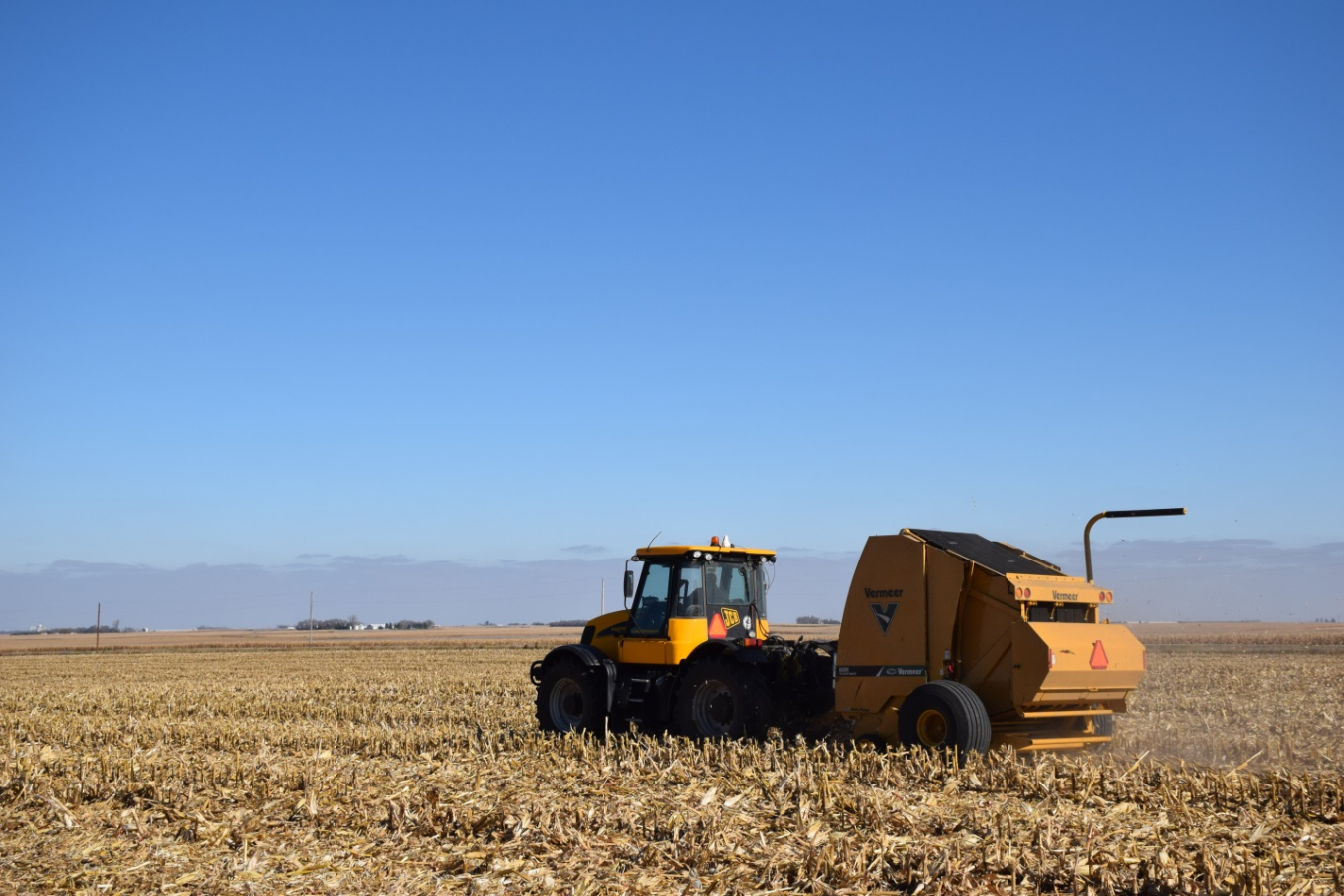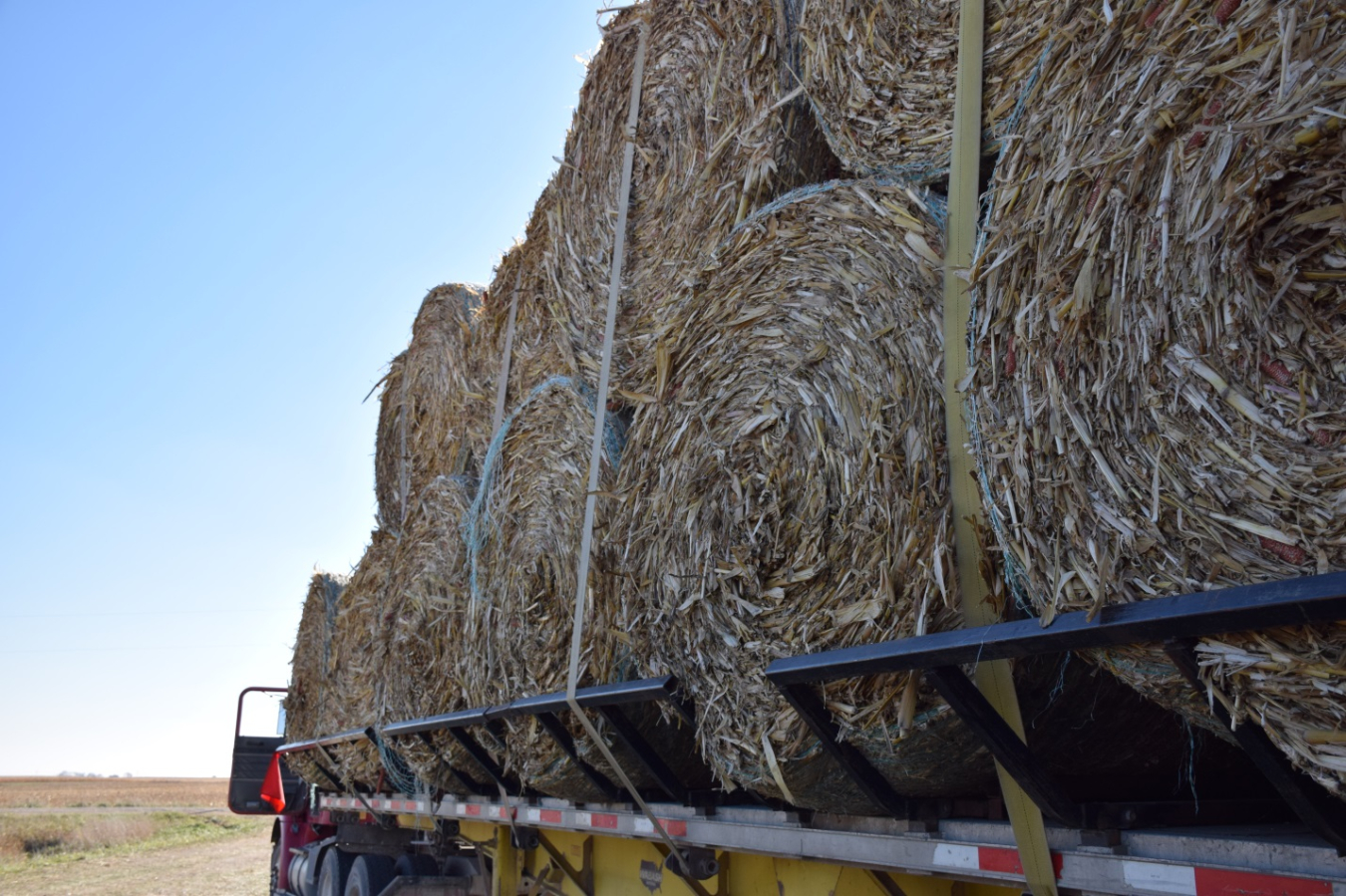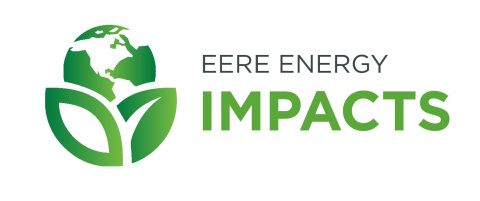POET, which later became POET-DSM through a joint venture, began experimental collection of biomass from more than 300 local farmers in Emmetsburg, Iowa.
Office of Critical Minerals and Energy Innovation
June 26, 2015
Farmer Bruce Nelson and a representative from biofuels company POET-DSM stand between square and round bales of corn stover stock piled outside of POET-DSM’s Project LIBERTY cellulosic ethanol biorefinery. Selling the corn plant residue after their corn harvest has generated a new revenue stream for many farmers, including Bruce. Watch a video segment about Bruce’s story at the beginning of the film “Bioenergy: America’s Energy Future.”

In a traditional corn harvest, corn stover (the remaining husks, stalks, stems, and leaves) is left on the field. Some corn stover can be used for animal feed and bedding, and farmers know that a base amount must be left on the field for healthy crop generation. However, the remaining corn stover does not have a use. Farmers can harvest it and sell it to a cellulosic biorefinery for the financial benefit of their farms. This photo shows harvesting equipment at an FDC Enterprises Demonstration Site near POET-DSM’s Project LIBERTY.

Farmers bale the corn stover into round (pictured here) or square bales and then transport them to the biorefinery.

Corn stover is stored at the biorefinery until it is ready to be processed into cellulosic ethanol. See what happens next to make cellulosic ethanol with an Energy Department photo slideshow.
For the past seven years, All-American football player and Iowa farmer Bruce Nelson has been using corn stover—the non-edible corn stalks, husks, and leaves of a corn plant—to generate extra income at his family farm in Emmetsburg, Iowa. Nelson, his father, and his uncle are traditionally corn farmers; however, ever since biofuels company POET-DSM began preparations for its new cellulosic ethanol plant in Emmetsburg in 2007, their leftover corn stover has been an additional new cash crop.
As preparation for constructing the Project LIBERTY biorefinery began, POET, which later became POET-DSM through a joint venture, began experimental collection of biomass from more than 300 local farmers in Emmetsburg, including Nelson and his family farm. Just as in the scale-up process for the biorefinery and fuel conversion process, testing the equipment on local farms near the biorefinery helped POET see what worked and what needed improvements to efficiently harvest and transport corn stover in preparation for the opening of their biorefinery. POET received $100 million in Energy Department cost-shared funding for construction of Project LIBERTY. This biorefinery held its grand opening in September 2014 and is now in the preparation stage for full-scale commercial biofuel production.
After two seasons of testing the equipment, POET began purchasing harvests of corn stover from the local farmers. They stock piled corn stover bales at the biorefinery for future production as construction of the biorefinery continued. Nelson and his family profited by selling their corn stover to POET and also started up a custom stover harvesting business to help local farmers who did not have the sufficient labor or equipment to sell their corn stover. Nelson said it was a great benefit to his farm—it helped him “add revenue without adding acres.”
“We’ve been harvesting biostover in a renewable and a sustainable way. Now we have a second cash crop,” Bruce said. Watch a video segment for more about his story.
To date, Emmetsburg is home to one of only three commercial-scale biorefineries in the country that are preparing for full-scale production of cellulosic ethanol. The others are Abengoa’s Bioenergy Biomass of Kansas cellulosic ethanol biorefinery in Hugoton, Kansas (using corn stover), and INEOS Bio-New Planet Energy’s facility in Vero Beach, Florida (using vegetative waste including palm fronds). The Bioenergy Technologies Office helps to fund integrated biorefineries across the nation that are helping to scale up biofuel technologies. The construction of biorefineries and biofuel production also create temporary and permanent biorefinery jobs.
As the market for cellulosic ethanol develops, it can continue to drive job creation and new revenue streams for farmers such as Nelson and his family. The Bioenergy Technologies Office has helped to make this new revenue stream possible by funding research, development, and demonstration projects to drive down the cost of advanced biofuel such as cellulosic ethanol.
Helping local farmers turn corn stover into a cash crop—just one of EERE’s energy impacts.
Valerie Sarisky-Reed

Valerie Sarisky-Reed is the director of the Bioenergy Technologies Office (BETO) in the Office of Critical Minerals and Energy Innovation (CMEI). In this role, she manages efforts to improve performance, lower costs, and accelerate market entry of bioenergy technologies. She assists in overseeing strategic planning to meet aggressive goals covered by the BETO research and development budget of approximately $250M annually, working with the U.S. Department of Energy's (DOE) national laboratories, academia, and industry.
Sarisky-Reed has more than 30 years of experience in addressing energy and environmental topics faced by the United States and globally. In addition to her programmatic activities, she is a founding member of the Metabolic Engineering Working Group, chartered by the Biotechnology Research Subcommittee, an inter-agency coordinating committee under the Office of Science and Technology Policy.
She also spent two years serving the chief scientist at the U.S. Department of Agriculture, helping to build bridges between DOE and the U.S. Department of Agriculture in support of the bioeconomy. As acting director for EERE's Wind Energy Technologies Office, she enabled the development of the most recent Multi-Year Program Plan, which focused heavily on bringing offshore wind to the United States.
The Bioenergy Technologies Office current focus areas include scaling up renewable hydrocarbon fuel technologies with an emphasis on SAF and on the recycle and upcycle of plastics through DOE’s Plastics Innovation Challenge, which aims to reduce ocean-bound plastic waste.
Sarisky-Reed holds a Ph.D. in biochemistry from Georgetown University and is a graduate of the U.S. Department of Commerce’s Senior Executive Service Career Development Program.



